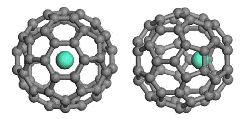Chemistry, Department of: Faculty Series

Xiao Cheng Zeng Publications
Document Type
Article
Date of this Version
7-22-1997
Abstract
The previous papers of this series introduced a molecular i / υ cluster theory of vapor phase nucleation. This theory differs from most conventional ones in that the cluster (due to fluctuation) is not only characterized by its number of particles i but also by a spherical volume υ. Thus the free energy of formation of the cluster is not merely a one-dimensional function of the number of particles i but a two-dimensional function of both i and v (i.e., it is a free energy surface). In the first stage of this development (Refs. 1–3) the theory is based on the i/ υ cluster with the i molecules inside a spherical volume υ whose surface is determined by a shell molecule while its center coincides with the center of mass of the i+1 molecules (see Fig. 1). The shell molecule is defined as the nearest vapor molecule to the cluster and there is no interaction between it and the cluster.


Comments
Published by American Institute of Physics. J. Chem. Physics 107 (4), 22 July 1997. ©1997 American Institute of Physics. Permission to use. http://jcp.aip.org/.